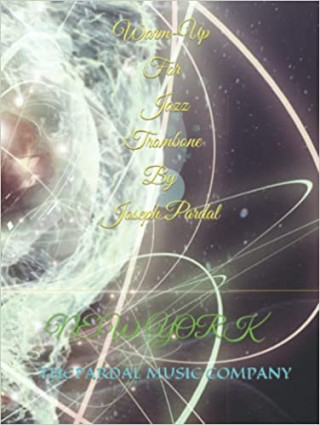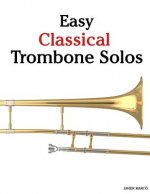
Kód: 41886454
Warm-Up For Jazz Trombone By Joseph Pardal Vol.1
Autor Jose Pardal Merza, Jose Lopez Perez, Nieves Lopez Morales
Warm-up book for jazz trombonists, classical etc. In the world of brass instrument players, many manias and diseases develop, such as Bell's palsy, oromandibular dystonia, bruxism, Satchmo syndrome and stage anxiety .Wind players ... celý popis
- Jazyk:
 Angličtina
Angličtina - Vazba: Brožovaná
- Počet stran: 138
Nakladatelství: Independently Published, 2022
- Více informací o knize

Mohlo by se vám také líbit
-

101 Disney Songs: For Trombone
566 Kč -

101 Most Beautiful Songs for Trombone
465 Kč -

Easy Classical Trombone Solos: Featuring Music of Bach, Beethoven, Wagner, Handel and Other Composers
302 Kč -

Easy Classical Trombone & Piano Duets: Featuring Music of Bach, Brahms, Wagner, Mozart and Other Composers
408 Kč -

Sex-Sex-Six
568 Kč -

Pokemon Adventures (Gold and Silver), Vol. 13
223 Kč -

Complete Book of Mah Jongg
348 Kč
Informovat o naskladnění knihy
Zadejte do formuláře e-mailovou adresu a jakmile knihu naskladníme, zašleme vám o tom zprávu. Pohlídáme vše za vás.
Více informací o knize Warm-Up For Jazz Trombone By Joseph Pardal Vol.1
 Anotace knihy
Anotace knihy
Warm-up book for jazz trombonists, classical etc. In the world of brass instrument players, many manias and diseases develop, such as Bell's palsy, oromandibular dystonia, bruxism, Satchmo syndrome and stage anxiety .Wind players are the most affected and represent 70% of patients in the profession. A 2009 study of 450 musicians from Argentina found that 53% had ever suffered injuries to muscles, tendons and joints, 22% from trauma and 17% from dystonia. .
Dystonia is a less frequent syndrome, but it also affects musicians, generating problems in the central nervous system, with involuntary movements triggered by a certain repetitive act. Oromandibular dystonia is a focal dystonia characterized by involuntary spasms of the masticatory, facial and muscular muscles. lingual. Different forms of oromandibular dystonia are distinguished: open, with lateral deviation and closed depending on the affected muscles.
Oromandibular closure dystonia is caused by
Dystonic spasms of the temporalis muscles and
masseters.
Mainly in this group suffer from problems in the muscles of the lips.
Satchmo syndrome, which is a muscle tear due to the effort of said muscle to make the instrument sound.
Oromandibular dystonia disorders of the temporomandibular joint, whose symptoms increase especially during practice. Playing wind instruments damages the blood vessels of the brain. Like athletes, they require regular and regular warm-up and especially in beginners. Coordination of the muscles of the face, lips and tongue helps to breathe! Knowing the correct way to warm up prevents medical side effects like tears and dramatically improves performance!
All this heating is coordinated with the facial muscles, the air, the lungs and the diaphragm, which is one of the strongest muscles in the human body. The diaphragm, which is located below the lungs, is the main muscle of respiration. It is an elongated, dome-shaped muscle that contracts rhythmically and continuously and, most of the time, involuntarily. As you inhale, the diaphragm contracts and flattens, and the chest cavity widens. This contraction creates a vacuum that draws air into the lungs. As you exhale, the diaphragm relaxes and returns to its dome shape, and air is expelled from the lungs. Emotions such as sadness, fear, anxiety, or stress can influence diaphragmatic activity or proper function. In turn, these emotions can cause alterations in the perception of pain. The activity of the diaphragm is also essential in maintaining posture and changes in body position, both because of its location and its insertion areas in the center of the body, and because of its isolated contractions; which has been shown to produce postural alterations depending on the position in which we find ourselves. At the level of the circulatory system, the diaphragm facilitates venous and lymphatic return; This is because its movements can cause changes in body pressure. This function It will be important for the absorption of substances from the peritoneal cavity, as well as for good blood circulation in the liver and abdomen. The pressures on the abdominal viscera produced by the movement of the diaphragm favor peristaltic movements and digestive function. , its gastroesophageal function is also relevant, since the crural part of the diaphragm prevents gastroesophageal reflux and intervenes in other important processes. Total control of the diaphragm is important to play any wind instrument.
 Parametry knihy
Parametry knihy
- Plný název: Warm-Up For Jazz Trombone By Joseph Pardal Vol.1
- Podnázev: New York
- Autor: Jose Pardal Merza, Jose Lopez Perez, Nieves Lopez Morales
- Jazyk:
 Angličtina
Angličtina - Vazba: Brožovaná
- Počet stran: 138
- EAN: 9798838165756
- ID: 41886454
- Nakladatelství: Independently Published
- Hmotnost: 336 g
- Rozměry: 279 × 216 × 8 mm
- Datum vydání: 25. June 2022
Oblíbené z jiného soudku
-

Dune
262 Kč -

Haunting Adeline
620 Kč -

Berserk Deluxe Volume 2
1092 Kč -

White Nights
90 Kč -

Powerless
260 Kč -

Atomic Habits
338 Kč -

Dune Messiah
183 Kč -

Berserk Deluxe Volume 3
1142 Kč -

One Day
276 Kč -

Berserk Deluxe Volume 1
1115 Kč -

Iron Flame
462 Kč -

Surrounded by Idiots
316 Kč -

Harry Potter and the Prisoner of Azkaban (Minalima Edition)
688 Kč -

Gravity Falls Journal 3
440 Kč -

Heaven Official's Blessing: Tian Guan Ci Fu (Novel) Vol. 1
440 Kč -

The Creative Act
586 Kč -

Dune
276 Kč -

Hunting Adeline
642 Kč -

A Little Life
276 Kč -

Children of Dune
174 Kč -

Heaven Official's Blessing: Tian Guan Ci Fu (Novel) Vol. 2
399 Kč -

Bungo Stray Dogs, Vol. 8 (light novel)
404 Kč -

Percy Jackson and the Olympians 5 Book Paperback Boxed Set
953 Kč -

Solo Leveling, Vol. 1
443 Kč -

The Prisoner's Throne
241 Kč -

Court of Thorns and Roses
254 Kč -

Cry Baby Coloring Book
255 Kč -

Fourth Wing
420 Kč -

Icebreaker
199 Kč -

Berserk Deluxe Volume 6
1089 Kč -

Avatar, the Last Airbender: The Kyoshi Novels (Box Set)
833 Kč -

The 48 Laws of Power
601 Kč -

House of Leaves
541 Kč -

Twisted Lies
213 Kč -

Dune Messiah
277 Kč -

No Longer Human
339 Kč -

48 Laws Of Power
480 Kč -

Twisted Games
213 Kč -

Caraval Paperback Boxed Set
905 Kč -

Solo Leveling, Vol. 2
351 Kč -

Open Circuits
910 Kč -

Berserk Deluxe Volume 5
1119 Kč -

Heaven Official's Blessing: Tian Guan Ci Fu (Novel) Vol. 3
441 Kč -

Berserk Deluxe Volume 4
1178 Kč -

Court of Mist and Fury
254 Kč -

SOLO LEVELING V08
436 Kč -

English File Upper Intermediate Multipack A (4th)
487 Kč -

CHAINSAW MAN V14
249 Kč -

Before the Coffee Gets Cold
276 Kč
Osobní odběr Praha, Brno a 12903 dalších
Copyright ©2008-24 nejlevnejsi-knihy.cz Všechna práva vyhrazenaSoukromíCookies



 Vrácení do měsíce
Vrácení do měsíce 571 999 099 (8-15.30h)
571 999 099 (8-15.30h)